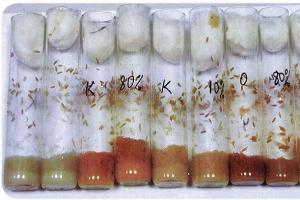White water lily, or water lily, or nymphea white (Nymphaea alba), has a flower of incredible beauty, truly worthy of worship. Therefore, the white water lily bears the proud titles of “queen of waters” and “northern”.
In my homeland, Belarus, the white water lily is found mainly in the Pripyat floodplain (sleeves, oxbow lakes, lower tributaries) in low-flowing water. This plant is included in the Red Book of the Republic, although in its usual habitat there are quite a lot of thickets of nymphs.
Another type of water lily - the pure white water lily - is widespread throughout Belarus. It has a number of differences, including the smaller size of the flowers and the less flawless white color of the petals.
Amateur flower growers often extract the rhizome of the water lily from a natural reservoir to be able to admire its royal flowers throughout the entire garden season.
Despite the tempting nature of breeding, the white water lily is difficult to cultivate - due to the need for an insignificant, but obligatory flow of water.
Water lily blooming
The water lily flower is the largest (up to 15 cm in diameter) in our climate.
The petals of the white water lily are truly dazzling white. During the day they are wide open, showing the golden center of the flower and emitting a faint aroma.
Picking the beautiful flowers of the white water lily is not only a criminal activity, but also meaningless: the plucked water lily withers immediately.
Around the buds and flowers of the nymphaeum there are large rounded leaves. They are glossy green, and the blades of their plates diverge to the sides. The petioles of the leaves go under water to the perennial rhizome, sometimes to quite a considerable depth.
The nymphea flower is pollinated mainly by beetles. They often spend the night in water lilies, eating pollen and being sprinkled with it.
Reproduction of nymphs
The seeds of the water lily ripen under water, and the shape of its fruit to a certain extent resembles a pitcher.
After ripening, the nymph seeds float to the surface. Their accumulations are very similar to fish eggs, thanks to which birds do not leave these seeds unattended, facilitating the dispersal of water lilies into water bodies.
The water lily also reproduces vegetatively.
Water lily in legends and tales
In the Middle Ages, the snow-white “queen of the waters” was a recognized symbol of purity. And the seeds of white nymphea were considered a means of moderating passions, and as such they were offered to the inhabitants of monasteries.
I won’t say about the water lily (who knows what is forgotten here, what is confused, and what requires closer study), but the preparations of its close relative have a contraceptive effect, this is a scientific fact.
White nymph under the name " swan flower"was an object of adoration among the Germanic tribes, and stylized images of water lilies were present on their standards and coats of arms.
It is impossible not to mention the magical properties attributed to the water lily. “Odolen-grass”... (in other Slavic languages this was the name given to valerian for its wonderful healing and magical qualities). And on East Slavic soil this name was transferred to the white water lily. Yes, and a pure white water lily, since the popular idea of a separate plant species is usually broader than the strictly botanical one: “a water lily is a water lily.”
According to ancient beliefs, the water lily drives away evil spirits and diseases.
Nymphea decoction was considered a love potion, and also helped with poisoning and toothache ( official medicine Only the hypotensive effect of alkaloids from the plant’s rhizome is recognized).
It was believed that overpowering grass helped in travel, so the dried parts of the plant were hidden on the chest when setting off on a journey.
"Overcome the grass! Overcome you evil people: They wouldn’t think anything bad about us, they wouldn’t think anything bad. Drive away the sorcerer, the sneaker. Overcome the grass! Overcome high mountains, low valleys, blue lakes, steep banks, dark forests, stumps and logs... I will hide you, overcoming grass, near a zealous heart, along the entire path and along the entire path" (from a conspiracy for a long journey, which is not only the lazy quote in relation to the water lily).
Water lily flowers open at about 7 a.m. and close in the evening at 6 p.m. This exact time of awakening and falling asleep of flowers allowed Linnaeus to include the nymphaeum in the list of “plant-flower clocks”.
It was Carl Linnaeus who gave water lilies their generic name in honor of mythological nymphs. And in the Slavic environment, the water lily flower was also firmly associated with local nymphs - mermaids. After all, the water lily, like the mermaid, is as attractive as it is destructive. At those depths where the nymphea grows, the waters are under the hunter for beautiful flower it will be enough to drown, entangled in its slippery strong stems...
Actually, if I could, I would only speak about the beautiful white water lily in poetry!
White water lily is the oldest representative aquatic plants. This plant exhibits many archaic characteristics. White water lily is a weather predictor.
There are about fifty species of this plant with beautiful flowers found in nature. The diameter of the flowers ranges from three to thirty centimeters. We have only three species of this plant. The most common one is white water lily.
The water lily plant is a representative of very ancient times. The first water lilies grew in ancient swamps and lakes back in the time of dinosaurs. Apparently this is why the plant has many archaic characteristics.
IN ancient Rus' The water lily was called overcoming grass. It was believed that it protects from all misfortunes, even helps from evil spirits and witchcraft.
You should not pick water lily flowers on a pond. Remember, the plant will certainly die if the stem is damaged. Please take care of this representative. ancient world. Nowadays, there is only one way to escape from evil spirits - to pay taxes on time.
The water lily grows, as in ancient times, in stagnant or low-flowing water at a depth of up to two meters. White water lily is a representative of perennial herbaceous plants.
White water lily - description.
There is a thick rhizome of dark brown color. Inside the rhizome there is a network of air channels designed both for the respiration of the plant and for the strength of the tissues of this plant.
The leaves are floating, round in shape. The diameter is up to 30 cm. The age of the plant can be approximately determined by the color of the leaves. Young water lilies have dark red leaves. Adults have dark green leaves above and purple leaves with a red tint below.
Water lilies have single, large flowers with three or four petals. They can be raised above the water on peduncles or simply float in the water. The aroma is delicate, weak. Flowering time is from June to September.
White water lily predictor of weather and bite.
Before sunset, the flowers close and are completely immersed in water. After sunrise, these flowers float up and after a while the buds open. This phenomenon does not happen every day.
In windy or rainy weather, the flowers do not open at all. The weather can be determined by this behavior of the water lily. If the flowers have not opened in the morning, then after a while there will be bad weather. And, conversely, if the flowers have opened, the weather will be calm and sunny.
There is also a sign for fishermen - if the buds do not open in the morning, then the fish have left these places.
Flowers are pollinated by various insects. The fruits ripen in autumn (September, October). The spherical fruits sink to the bottom and ripen there. Seeds in the shell fall out of them.
The shells are filled with air, and the seeds float to the surface. The wind and waterfowl carry the seeds throughout the water area. Water lilies rarely grow alone; they usually form thickets in which fish spawn.
Such thickets are an excellent refuge for fish. The thickets serve not only as a refuge, but also as a dining area for aquatic inhabitants. The rhizomes of the plant contain starch, protein, essential oil, tannins and alkaloid nymphalides.
Various waterfowl, aquatic animals (muskrats, beavers) and fish such as rudd, perch, and roach feed on the seeds and rhizomes. Anglers know where roach and rudd are, and pike are also found there.
White water lily and traditional medicine.
- In the absence of medicines in the pond, the leaves of the white water lily can be used as an anti-inflammatory agent. White water lily is used to treat various diseases.
- Doctors recommend using flower infusions for insomnia, neuroses, and as an analgesic and antipyretic. Decoctions from the roots help with jaundice and tuberculosis. A tincture of the leaves is recommended for the treatment of urolithiasis.
- IN folk medicine white water lily is used more widely. Since ancient times, water lilies have been used to treat toothache, convulsions. For rheumatism, tinctures of rhizomes in vodka were used as an external remedy.
- Tinctures from leaves and flowers cleanse well and whiten the skin with freckles and acne. It is believed that a decoction of the roots in beer when washing your hair protects hair from loss.



There are about 50 species of water lilies, which are distributed almost throughout the globe, in tropical and temperate zones. Flowers with a diameter of 3 to 30 cm, of different colors: white, pink, blue, purple, etc. In many species, the transition of stamens to petals is clearly visible. There are 3 species in Russia. , or snow-white, common in the European part.
The Latin name for the water lily is Nymphaea, literally translated as “little nymph.” In ancient mythology, nymphs were the name given to lower female deities.
The beautiful flowers of the white water lily float to the surface of the reservoir in the early morning and bloom in the form lush rose, exuding a delicate aroma. In the evening, the flower closes and plunges back into the water. You should not pick wonderful flowers, as the plant suffers greatly from this. As a rule, the water lily dies due to damage to the stem.
In order for the leaf to float and for better movement of air and water vapor, its entire inner fabric is riddled with channels and resembles a sponge, that’s why it’s called spongy.
Large white flowers with numerous petals and yellow stamens float on the surface of the water. Leaves grow only at the end of a thick, branched rhizome that lies at the bottom. Its entire surface is covered with darker traces of dead leaves, looking like brown diamonds on a light yellow background, which make the rhizome look like a large spotted snake. Thick light roots are formed only on the lower side of the rhizome and look like numerous legs.
Amazing water lily flowers seem to be covered with wax. IN Ancient Greece their petals were sprinkled on the wedding bed of the newlyweds and decorated with the clothes of the gods. The Egyptians worshiped the beauty of water lilies, depicting these plants on gravestones. The red water lily, brought to Egypt from India, served as a symbol of the divine origin of royal power. Wreaths were woven from the plant and placed on the head of the new pharaoh who came to power.
A huge number of legends and superstitions are associated with the water lily. The very Latin name of the flower - nymphea, goes back to the Greek legend about a nymph who turned into a snow-white flower from an unhappy love for Hercules, every morning she floats to the surface of the water, the flower opens, and the nymph peers into the distance in search of her lover, and at night she disappears into the water again. Since water lily flowers appear on the surface at about seven o'clock in the morning and go under water at seven o'clock in the evening, the picture depicted in Kramskoy's famous canvas, where mermaids walk among water lilies in the moonlight, is simply impossible. The attitude towards the water lily in Western Europe is probably a distant echo of this legend. In ancient German and some West Slavic fairy tales it is called nenyufar or dead lily and it is believed that mermaids and vampires turn into its flowers during the day. In Russian mythology, this plant is called overpowering grass. She was supposed to protect from all misfortunes and troubles, including witchcraft and evil spirits. When going on the night of Ivan Kupala to look for blooming ferns, you had to take the grass with you. According to Slavic legends, mermaids drove men crazy who wanted to pick water lilies, luring the unfortunate ones into the underwater kingdom. Very interesting are the stories of North American Indians, who claim that water lilies were formed from sparks that arose as a result of the collision of stars.
This living decoration reservoirs is one of the first herbaceous plants on our planet; it appeared on lakes shortly before the extinction of dinosaurs and retained many archaic features in its structure. For example, a flower is designed in an extremely primitive way. Initially, angiosperm flowers did not have petals. Petals, designed to attract pollinating insects, appeared much later, in the process of gradual formation from stamens. From water lily flowers one can trace all stages of the transformation of stamens into petals.
The water lily is pollinated by insects, and after flowering its berry-like fruit goes under water. There it rots after ripening, and the seeds, surrounded by an air-filled shell, float to the surface of the water.
Water lilies often form thickets that serve as spawning grounds for fish. The rhizomes and seeds of the plant serve as food for waterfowl, muskrats, beavers, muskrats and other aquatic animals, thanks to which they are spread across lakes, ponds and rivers. Many types of water lilies are grown as ornamental plants.
Snow-white or pure white water lily (Nymphaea Candida J.Presl)
Description of appearance:
Flowers: Fragrant flowers with a diameter of 10-12 (up to 20) cm float on the surface of the water. The flower consists of 3-5 oblong sepals, numerous white petals. The base of the calyx is quadrangular, prominent; sepals with 5-7 obscure veins. The outer petals are large, and the closer to the center of the flower, the smaller they are; the innermost ones are very similar to stamens. Stamens are numerous. The pistil is large, with a yellow flat stigma. The flowers close in the evening and submerge in water; in the morning they float up and open again, but in rainy weather do not open during the day. After flowering, the peduncle curls and the fruit develops in water.
Leaves: Long-petioled leaves with a heart-shaped oval or rounded blade with a diameter of 10-30 cm, dark green above and with a reddish-purple tint below (young leaves are redder) float on the surface of the water.
Root: With a thick dark brown rhizome, which is located horizontally at the bottom of the reservoir, only slightly covered with silt. The rhizome is covered with the remains of petioles of fallen leaves, leaves and pedicels extend from it.
Flowering and fruiting time: Blooms from June to September. The fruits ripen in August-October.
Lifespan: Perennial.
Habitat: The pure white water lily grows in standing and slowly flowing waters at depths of up to 2 m. It often forms extensive thickets.
Prevalence: Mostly European look, found in the Caucasus and Central Asia. In Russia, it is distributed in the European part and in the south of Siberia. Common in many areas of Central Russia.
Addition: The flowers are very beautiful, which is why the water lily is often called a white water lily. Unfortunately, the plant began to disappear from reservoirs near densely populated areas, as its flowers are constantly being torn off. Pollution of water bodies also matters - the water lily prefers clean water. In some southern regions there is European White water lily (Nymphaea alba L.), having a rounded calyx base and usually flowers sticking out of the water. Rarely found in the northern regions Small or tetrahedral water lily (Nymphaea tetragona Georgi), with small flowers, up to 5 cm in diameter.
White water lily
Medicinal properties and uses
White water lily|Nymphaea alba|genus Water lilies|family Water lilies
● Treatment plant White water lily is also popularly called overpowering grass, water or white lily and white water lily (not to be confused with yellow water lily). Dear friends and blog readers " Traditional medicine recipes»!
On this page I want to tell you how white water lily is useful in folk medicine. This medicinal herb is one of the favorite plants of the peoples of Russia and the former Soviet Union.
The white water lily has rightfully won such love because of many useful properties, thanks to which healers and herbalists, healers and sorcerers treat many diseases.
● An infusion of flowers in Russian villages is used as a diaphoretic antipyretic and to quench thirst in patients with fever. In addition, village peasants use this infusion as a sleeping pill and sedative for.
The active substances of the rhizomes of the white water lily eliminate inflammatory manifestations on. Since ancient times, people have been treating it by applying crushed roots of the plant to the lower back, after which a burning sensation began and the pain subsided.
● To relieve pain, traditional medicine recommends applying pieces of fresh white water lily root to the cheek opposite the sore tooth, and the infusion of the flowers has an analgesic effect in the form of baths; A long-term decoction (up to 2 hours) removes freckles, skin rashes and tanning.
Traditional medicine recipes
● Boil three tablespoons of dry or fresh plant flowers with boiling water several times, wrap in gauze and apply to the sore spot to relieve pain.
● Infuse three tablespoons of crushed leaves in half a liter of boiling water for half an hour. Use externally as a compress to relieve inflammatory processes on the skin.
● Let two tablespoons steep in 500 ml of boiling water for twenty minutes, then filter through two layers of gauze. This cosmetic product used to get rid of freckles, tanning and acne.
● Pass several roots of the white water lily through a meat grinder and apply as a compress to the painful areas of the lower back with radiculitis.
● Infuse two tablespoons of flower petals in half a liter of boiling water for 20 minutes, then filter. We take a tablespoon of infusion 3-4 times a day after meals as a sleeping pill and sedative.
● Treatment of neuroses:
- 250 ml of boiling water, 5 g of dried flowers, leave for 20 minutes. Two to three cups a day;
- Boil 5 g of dried rhizome in a glass of boiling water for 15 minutes. 2-3 cups per day.
● Treatment of solar erythema, , and scratches on the skin:
— moisten a cloth (gauze) in the decoction described above and apply to the problem area of the skin 3 to 6 times a day.
Thank you, friend, for reading the article to the end. May God grant you good health!
White water lily (white water lily) is an aquatic herbaceous long-rhizome plant that grows in lakes, ponds and creeks of slow-flowing rivers at a depth of 30-200 cm.
The rhizome is thick, branched, up to 3 cm in diameter, dark brown in color, located horizontally. The leaves are glossy green, rounded, core-oval, 12-30 cm long on long (up to 5 m) petioles. White water lily flowers– up to 15 cm in diameter, petals – numerous, white, outer ones – larger than the inner ones. In the center of the flower is the stigma, which is a yellow disk with 8-24 rays. The flowering of the white water lily begins in mid-summer and continues until autumn.

How does white water lily reproduce?
The plant reproduces by seeds (the seeds remain viable even if the pond freezes through) and vegetatively (by branching the rhizome). White water lily seeds mature underwater and then float to the surface. Clusters of seeds resemble fish eggs, which attracts birds - thus the white water lily is transferred to other bodies of water. The plant is found in single specimens or small clusters.  The main reasons for the decline in plant numbers:
The main reasons for the decline in plant numbers:
- pollution, shallowing and drying up of water bodies
- collection of plant rhizomes for medicinal purposes and flowers during flowering.
Some amateur gardeners needlessly destroy water lilies, removing rhizomes from their natural habitat in order to place them in a garden pond. It is worth noting that water lilies are difficult to cultivate due to the fact that their normal functioning requires a weak, but D.C. water.
Where is white water lily used?
Using white water lily in medicinal purposes in folk medicine due to the fact that the plant contains a huge amount of tannins, which protect it from rotting in water, as well as alkaloids.
The water lily rhizome consists of 49% starch, 20% sugar and 9% protein. For medicinal purposes, both rhizomes and leaves, flowers and fruits of the plant are used. They are used to make painkillers and hemostatic agents, anti-inflammatory infusions and remedies for acne and freckles.








